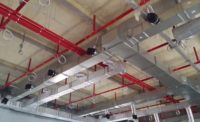Following my January article, “A Job Not Well Done,” which was published in Engineered Systems, I received an email from Mark Goransrud, RSE, chief estimator, Kesil Test & Balance Ltd., who endorsed my recommendation that third-party testing, adjusting, and balancing (TAB) should be integral with third-party HVAC commissioning. He also stated he is aware of insurance companies giving back/crediting building owners for being code-compliant with fire damper inspection requirements.
To his point, I looked up National Fire Protection Association (NFPA) 80(10), Sec. 19.4. 1.1, which requires testing and inspection of fire dampers and noted the following:
- Each fire damper shall be inspected one year after installation;
- Each fire damper shall be inspected every four years, except for hospitals, where the frequency is allowed to be every six years.
While the NFPA recommendations are not code, they are referenced by various state codes that are then embraced and legally enforceable as part of the specific code. As a design engineer, fire dampers must be shown on the contract drawings for a building program project, but how many design engineers note on these contract documents that fire dampers require an inspection one year after the project is complete? Quite often, a third-party commissioning agent is retained during the warranty period to follow the HVAC system performance to assure a continued commissioning success, so why isn’t the first-year TAB technician fire damper inspection included in the project’s warranty phase contract requirement? The same can be said for building owners and facility managers who are not cognizant of fire damper inspection requirements when their states recognize NFPA and, more specifically, NFPA 80(10), Sec. 19.4. 1.1?
This discussion reminded me of a building owner who contracted my consulting services to oversee the inspection of an existing building his organization had purchased where he questioned the operating conditions of the HVAC system’s fire dampers. To begin the survey process, a local, certified TAB firm was hired to complete this inspection, and I requested the TAB technician take existing condition photographs of each damper to confirm compliance or noncompliance. From the inspection, this technician then documented as-built fire damper locations on the building’s HVAC record drawings.
When completed, the corrective action survey documented the following:
- Six fire dampers, partly closed;
- Two fire dampers held open, each with a brick; and
- Four fire dampers missing from the original record drawings.
So, after writing my January feature article, receiving Mr. Goransrud’s email, and recalling the fire damper survey I was involved with, all of this simply emphasizes:
- Third-party, certified TAB services contribute to life safety;
- Third-party, certified TAB services contribute to complete commissioning of a building; and
- Third-party, certified TAB services can contribute to insurance rebates.
Note: Don’t forget smoke dampers when contracting for fire damper inspections.





